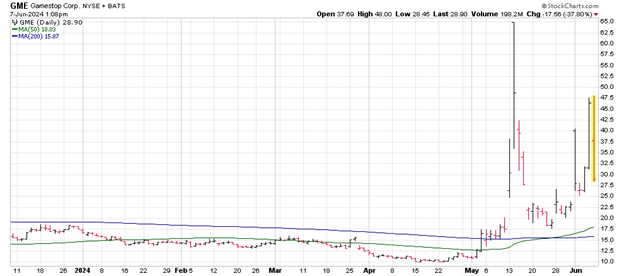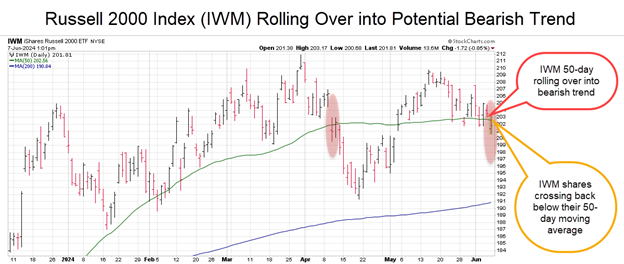You’re going to hear a lot more about this from me on Monday, but the situation with “Roaring Kitty” may become one of the most critical stories for you, the individual investor, over the next six months.
Something is up, and it’s not good for “markets.”
Consider this…
Roaring Kitty’s (A.K.A Keith Gill) recent screenshot of his personal position in GameStop (GME) reflected a 5% ownership of the company. His recent headlines have resulted in the stock rallying as much as 275%.
Compare this to one of the most successful investors of all time, Warren Buffett. Buffett made news when it was released that his company, Berkshire Hathaway (BRK.A), had purchased 6.4% of Chubb insurance last month.
Chubb (CB) stock rallied 8% on that news.
The most recent short interest data for GameStop shows a short interest ratio of 2.45 along with a short interest to float ratio of 25%. Both figures have dropped of late, suggesting that the upside volatility is less likely to be driven by a short squeeze, but instead a simple wave of speculative buying.
GameStop confirmed as much this morning when the company released their quarterly earnings results a week earlier than scheduled.
The results were bad. Missed earnings, missed revenue and management decided not to host a conference call today.
The company did announce that they filed a prospectus supplement for the sales agreement of up to 75 million shares of Class A common stock.
GameStop raised approximately $933 billion in May by selling shares with a disclosed at-the-market offering of 45,000,000 shares. The company just filed to sell another 75,000,000 shares, raising more capital while the stock is riding high on speculation, not the fundamentals.
They’re not dummies, they’re raising cash while they can. It’s as if they’re writing checks from their bank account after they noticed someone accidentally deposited billions
Investors often feel like they can’t beat “Wall Street.” Stories like the ones that we’re likely to read over the coming months about GameStop are a big part of the reason.
As I said, I’ll have more on this Monday, but for today there’s a thesis at work here that connects with my comments below on the Russell 2000 Index.
Good News is Bad News
It’s turned into one of those types of markets.
This morning’s jobs report was better than what Wall Street was looking for as Nonfarm payrolls grew by 272,000 when economists were looking for only 190,000. At the same time, unemployment hit 4% for the first time since January 2022.
The stronger jobs growth contrasts with jobs data from earlier this week, which is one of the reasons that the market started the day slightly lower.
The real problem, from an investor’s perspective, was the jump in wages for the month.
Average hourly earnings were higher than expected, rising 0.4% in the month of April. Wages are now 4.1% higher than they were last year, which is another sign that inflation may still be stubbornly lingering.
That’s a problem for stocks as we saw the “hope” trade kick in to high gear earlier this week.
Two things have been driving the markets to all-time highs.
Speculation on a very small group of technology companies like Nvidia (NVDA) and Apple (AAPL), and speculation that the Fed will start cutting interest rates sooner than the data says.
This morning’s report takes one of those catalysts off the table as the bond market is selling off in anticipation of higher interest rates sticking around longer.
Pro Tip: Keep an eye on the small cap Russell 2000 for your indication of where this market is really going to head. It’s more sensitive to interest rates and isn’t intimidated by the Mag Seven effect of creating the illusion of a market that is stronger than reality.
Let’s Talk About Small-Cap Stocks for a Minute
When I coached high school hockey, I would always tell my players to watch their opponents’ hips, that would always tell you the direction of where the player was getting ready to move. Think of the Russell 2000 as the market’s “hips.”
As I just said, the Russell 2000 is the reality of the market. It’s performance isn’t buoyed by a few stocks, instead it represents the real market. For that reason, it’s the one index to watch for a gauge of where the rest of the market is heading.
Let’s combine that knowledge with the 50-day moving average. The 50-day moving average is the one trendline that captures the essence of “the trend is your friend.”
The Russell 2000 Index ETF (IWM) has spent the last week fighting to stay above its 50-day trendline. Today’s selling pressure is seeing the IWM back below this critical trendline on increasing volume. That’s a telltale sign that investors are backing off on their speculative interest in stocks.
One of my favorite sayings is that “markets are driven higher by speculation, not fundamentals.”
The saying carries even more water right now as we’re exiting the earnings season, meaning that there will be fewer “fundamentals” and headlines to help fuel the speculators.
Watch the chart below with me over the next week as it is going to determine the next 10-15% move in the S&P 500 (SPY) and Nasdaq 100 (QQQ).
Adding to the risk for the market is the fact that the IWM is preparing to break below a key volatility trigger.
A move below $200 will take out round numbered support as well as the IWM’s bottom Bollinger Band. The Bollinger Band is a measure of potential volatility.
The combination of the IWM’s 50-day, round-numbered $200 level and Bollinger Band break should have investors and traders preparing for a rough couple of weeks for stocks.
Here’s How to Trade This
Get “shorty.” Look at the ProShares UltraPro Short Russell 2000 ETF (SRTY), ticker symbol SRTY. This ETF moves inversely to the IWM at a 3:1 leverage rate. That means that the SRTY shares will go up roughly 3% for every 1% the Russell 2000 drops. It’s an easy and effective way to hedge a quick drop in stocks.
Pro Tip 2: Determine a target price for the IWM Russell 2000 when entering a hedge like this. Currently the chart points to a potential drop to $190 or about 10%. That move would result in a 30% increase in the SRTY shares. Take profits when they are there and consider cutting the hedge off if the IWM breaks above $205.
About the Author
Chris Johnson (“CJ”), a seasoned equity and options analyst with nearly 30 years of experience, is celebrated for his quantitative expertise in quantifying investors’ sentiment to navigate Wall Street with a deeply rooted technical and contrarian trading style.





